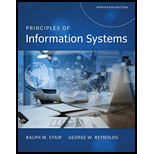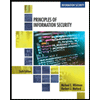
Principles of Information Systems (MindTap Course List)
13th Edition
ISBN: 9781305971776
Author: Ralph Stair, George Reynolds
Publisher: Cengage Learning
expand_more
expand_more
format_list_bulleted
Concept explainers
Question
Chapter 10, Problem 1CTQ1
Program Plan Intro
Knowledge management:
- Knowledge management is the set of practices that are alarmed with:
- Increasing awareness
- Developing learning
- Speeding teamwork
- Innovation and
- Exchange insights
- The aim of knowledge management is to gather and document the valuable tacit knowledge of others and turn that into an explicit knowledge so that it can be shared with others.
Types of knowledge management: There are two types of knowledge management. They are:
- Explicit knowledge:
- Explicit knowledge is an expressive knowledge that can be articulated, accessed, documented, and codified.
- It is expressed in terms of words, symbols, and numbers.
- This knowledge is easily conveyed to others. It is stored in media.
- Tacit knowledge:
- It cannot be documented like explicit knowledge rather it is embedded according to the experiences of the individuals.
- It is unwritten and has hidden knowledge.
- It is hard to transfer to other individuals because it is difficult to verbalize.
Expert Solution & Answer
Trending nowThis is a popular solution!

Students have asked these similar questions
Information Security Risk and Vulnerability Assessment
1- Which TCP/IP protocol is used to convert the IP address to the Mac address? Explain 2-What popular switch feature allows you to create communication boundaries between systems connected to the switch3- what types of vulnerability directly related to the programmer of the software?4- Who ensures the entity implements appropriate security controls to protect an asset?
Please do not use AI and add refrence
Find the voltage V0 across the 4K resistor using the mesh method or nodal analysis. Note: I have already simulated it and the value it should give is -1.714V
Resolver por superposicion
Chapter 10 Solutions
Principles of Information Systems (MindTap Course List)
Ch. 10.1 - Prob. 1RQCh. 10.1 - Prob. 2RQCh. 10.1 - Prob. 1CTQCh. 10.1 - Prob. 2CTQCh. 10.2 - Prob. 1RQCh. 10.2 - Prob. 2RQCh. 10.2 - Prob. 1CTQCh. 10.2 - Prob. 2CTQCh. 10.3 - Do research to find out how the school can sign up...Ch. 10.3 - Prob. 2RQ
Ch. 10.3 - Prob. 1CTQCh. 10.3 - What potential barriers to implementing this...Ch. 10.4 - What sort of training and experience is needed by...Ch. 10.4 - Prob. 2RQCh. 10.4 - Prob. 1CTQCh. 10.4 - Prob. 2CTQCh. 10 - Prob. 1SATCh. 10 - Prob. 2SATCh. 10 - Prob. 3SATCh. 10 - Prob. 4SATCh. 10 - Prob. 5SATCh. 10 - Prob. 6SATCh. 10 - Prob. 7SATCh. 10 - Prob. 8SATCh. 10 - Prob. 9SATCh. 10 - Prob. 10SATCh. 10 - Prob. 11SATCh. 10 - Prob. 12SATCh. 10 - Prob. 13SATCh. 10 - Prob. 14SATCh. 10 - Prob. 15SATCh. 10 - Prob. 16SATCh. 10 - Prob. 17SATCh. 10 - Prob. 1RQCh. 10 - Prob. 2RQCh. 10 - Prob. 3RQCh. 10 - Prob. 4RQCh. 10 - Prob. 5RQCh. 10 - Prob. 6RQCh. 10 - Prob. 7RQCh. 10 - Prob. 8RQCh. 10 - Prob. 9RQCh. 10 - Prob. 10RQCh. 10 - Prob. 11RQCh. 10 - Prob. 12RQCh. 10 - Prob. 13RQCh. 10 - Prob. 14RQCh. 10 - Prob. 15RQCh. 10 - Prob. 16RQCh. 10 - Prob. 17RQCh. 10 - Prob. 18RQCh. 10 - Prob. 19RQCh. 10 - Prob. 20RQCh. 10 - Prob. 21RQCh. 10 - Prob. 22RQCh. 10 - Prob. 23RQCh. 10 - Prob. 1DQCh. 10 - Prob. 2DQCh. 10 - Prob. 3DQCh. 10 - Prob. 4DQCh. 10 - Prob. 5DQCh. 10 - Prob. 6DQCh. 10 - Prob. 7DQCh. 10 - Prob. 8DQCh. 10 - Prob. 9DQCh. 10 - Prob. 10DQCh. 10 - Prob. 11DQCh. 10 - Prob. 12DQCh. 10 - Prob. 13DQCh. 10 - Prob. 1PSECh. 10 - Prob. 3PSECh. 10 - Prob. 3TACh. 10 - Prob. 2WECh. 10 - Prob. 3WECh. 10 - Prob. 1CECh. 10 - Prob. 3CECh. 10 - Prob. 1CTQ1Ch. 10 - Prob. 2CTQ1Ch. 10 - Prob. 3CTQ1Ch. 10 - Prob. 4CTQ1Ch. 10 - Prob. 5CTQ1Ch. 10 - Prob. 1CTQ2Ch. 10 - Prob. 2CTQ2Ch. 10 - Prob. 3CTQ2
Knowledge Booster
Learn more about
Need a deep-dive on the concept behind this application? Look no further. Learn more about this topic, computer-science and related others by exploring similar questions and additional content below.Similar questions
- Describe three (3) Multiplexing techniques common for fiber optic linksarrow_forwardCould you help me to know features of the following concepts: - commercial CA - memory integrity - WMI filterarrow_forwardBriefly describe the issues involved in using ATM technology in Local Area Networksarrow_forward
- For this question you will perform two levels of quicksort on an array containing these numbers: 59 41 61 73 43 57 50 13 96 88 42 77 27 95 32 89 In the first blank, enter the array contents after the top level partition. In the second blank, enter the array contents after one more partition of the left-hand subarray resulting from the first partition. In the third blank, enter the array contents after one more partition of the right-hand subarray resulting from the first partition. Print the numbers with a single space between them. Use the algorithm we covered in class, in which the first element of the subarray is the partition value. Question 1 options: Blank # 1 Blank # 2 Blank # 3arrow_forward1. Transform the E-R diagram into a set of relations. Country_of Agent ID Agent H Holds Is_Reponsible_for Consignment Number $ Value May Contain Consignment Transports Container Destination Ф R Goes Off Container Number Size Vessel Voyage Registry Vessel ID Voyage_ID Tonnagearrow_forwardI want to solve 13.2 using matlab please helparrow_forward
- a) Show a possible trace of the OSPF algorithm for computing the routing table in Router 2 forthis network.b) Show the messages used by RIP to compute routing tables.arrow_forwardusing r language to answer question 4 Question 4: Obtain a 95% standard normal bootstrap confidence interval, a 95% basic bootstrap confidence interval, and a percentile confidence interval for the ρb12 in Question 3.arrow_forwardusing r language to answer question 4. Question 4: Obtain a 95% standard normal bootstrap confidence interval, a 95% basic bootstrap confidence interval, and a percentile confidence interval for the ρb12 in Question 3.arrow_forward
arrow_back_ios
SEE MORE QUESTIONS
arrow_forward_ios
Recommended textbooks for you
 Fundamentals of Information SystemsComputer ScienceISBN:9781337097536Author:Ralph Stair, George ReynoldsPublisher:Cengage Learning
Fundamentals of Information SystemsComputer ScienceISBN:9781337097536Author:Ralph Stair, George ReynoldsPublisher:Cengage Learning Principles of Information Systems (MindTap Course...Computer ScienceISBN:9781305971776Author:Ralph Stair, George ReynoldsPublisher:Cengage Learning
Principles of Information Systems (MindTap Course...Computer ScienceISBN:9781305971776Author:Ralph Stair, George ReynoldsPublisher:Cengage Learning Principles of Information Security (MindTap Cours...Computer ScienceISBN:9781337102063Author:Michael E. Whitman, Herbert J. MattordPublisher:Cengage Learning
Principles of Information Security (MindTap Cours...Computer ScienceISBN:9781337102063Author:Michael E. Whitman, Herbert J. MattordPublisher:Cengage Learning Systems ArchitectureComputer ScienceISBN:9781305080195Author:Stephen D. BurdPublisher:Cengage Learning
Systems ArchitectureComputer ScienceISBN:9781305080195Author:Stephen D. BurdPublisher:Cengage Learning Principles of Information Systems (MindTap Course...Computer ScienceISBN:9781285867168Author:Ralph Stair, George ReynoldsPublisher:Cengage Learning
Principles of Information Systems (MindTap Course...Computer ScienceISBN:9781285867168Author:Ralph Stair, George ReynoldsPublisher:Cengage Learning

Fundamentals of Information Systems
Computer Science
ISBN:9781337097536
Author:Ralph Stair, George Reynolds
Publisher:Cengage Learning

Principles of Information Systems (MindTap Course...
Computer Science
ISBN:9781305971776
Author:Ralph Stair, George Reynolds
Publisher:Cengage Learning

Principles of Information Security (MindTap Cours...
Computer Science
ISBN:9781337102063
Author:Michael E. Whitman, Herbert J. Mattord
Publisher:Cengage Learning


Systems Architecture
Computer Science
ISBN:9781305080195
Author:Stephen D. Burd
Publisher:Cengage Learning

Principles of Information Systems (MindTap Course...
Computer Science
ISBN:9781285867168
Author:Ralph Stair, George Reynolds
Publisher:Cengage Learning